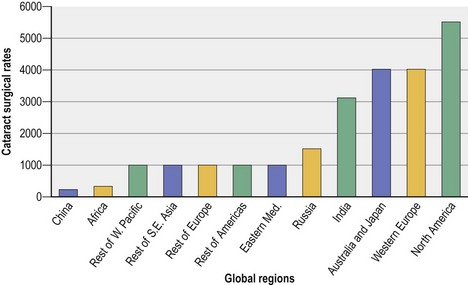CHAPTER 4 Cataract surgery
An introduction
The need for cataract surgery
If the CSR is 2000–3000, or more people who become blind due to cataract will be treated, the backlog will be abolished over a period of approximately 5 years. This applies if a visual acuity of <6/60 is used as the indication for surgery; a higher visual acuity cut-off will increase the required CSR. Figure 4.1 shows the CSR in WHO defined regions; only four regions have an adequate rate and millions of people have minimal or no access to surgery1.
Cataract surgery outcomes
The solution to the world’s unmet need would seem to be increasing the number of operations but it is not sufficient to simply perform more surgery; the visual result of the procedure must be of the highest possible standard. Cataract surgery is a potentially sight restoring operation and our aim as surgeons must be to deliver the best possible visual outcomes with the lowest possible complication rate. Continuous monitoring of both individual and national outcomes is well-established practice in all modern eye units. Unfortunately this practice is not always a priority in developing countries where resources are scarce and a culture of audit and accountability is not necessarily well established. Yorston et al.2 have established the role of prospective monitoring in improving surgical outcomes.
The World Health Organization (WHO) has defined standards for the outcomes of cataract surgery (Fig. 4.2
Stay updated, free articles. Join our Telegram channel

Full access? Get Clinical Tree



